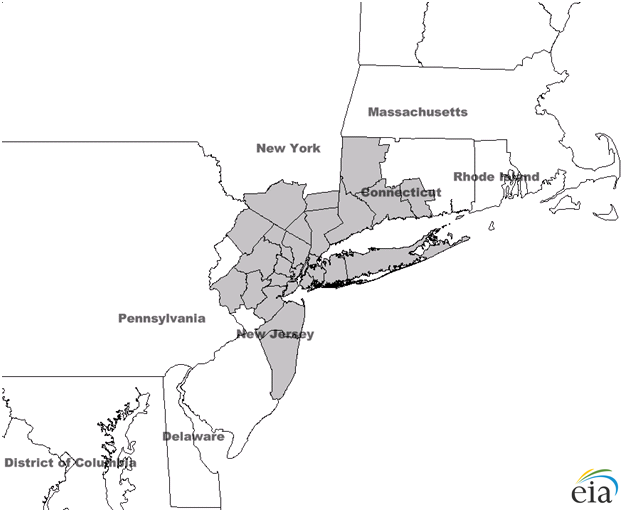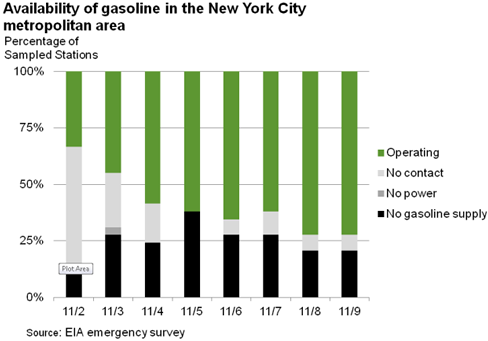
EIA initiates daily gasoline availability survey for metropolitan New York
This article was updated as new survey results were published. See the final report. All updates are included below.

Final Report
November 9, 2012
The U.S. Energy Information Administration (EIA) estimates that 28% of gas stations across the New York City metropolitan area do not have gasoline available for sale today, same as yesterday and down from 67% last Friday when EIA began its emergency survey. Despite the improvement since last Friday, the 28% remains a significant problem. Some counties in New Jersey, New York City, and Nassau and Suffolk counties have addressed this issue by imposing license plate allocation of gasoline. For further information on efforts to provide gasoline supplies to the affected area, please go to the Department of Energy's Helping Local Officials Address Fuel Shortages page.
Hurricane Sandy struck the U.S. East Coast on Monday, October 29, 2012. As a result of the subsequent disruptions to the supply chain for gasoline, EIA implemented an emergency survey starting on Friday, November 2, 2012, to monitor the vehicle fuel supply conditions in the New York City metropolitan area on a temporary basis. Today's report is the last for this emergency survey.
Today's number includes stations that reported no gasoline available and those assumed closed because EIA could not reach them after numerous attempts. Of the stations sampled, 72% reported gasoline available for sale (same as yesterday), 21% reported no gasoline supplies (same as yesterday), and 7% did not respond to attempts to contact them (same as yesterday).

| Station Response | Friday Nov. 2 |
Saturday Nov. 3 |
Sunday Nov. 4 |
Monday Nov. 5 |
Tuesday Nov. 6 |
Wednesday Nov. 7 |
Thursday Nov. 8 |
Friday Nov. 9 |
|---|---|---|---|---|---|---|---|---|
| No gasoline supply | 10% | 28% | 24% | 38% | 28% | 28% | 21% | 21% |
| No power | 3% | 3% | 0% | 0% | 0% | 0% | 0% | 0% |
| No contact | 53% | 24% | 17% | 0% | 7% | 10% | 7% | 7% |
| Operating | 33% | 45% | 59% | 62% | 66% | 62% | 72% | 72% |
EIA's estimate of stations without gasoline available for sale is a composite number not designed to reflect the specific experience of more severely affected areas. For more detailed information on gasoline availability, power outages, shelter and recovery centers, local emergency Twitter feeds, FEMA disaster declared areas and more, please go the Google Emergency Map available through the Department of Energy's website.
To develop the emergency survey, EIA used the representative sample of retail stations selling gasoline used in EIA's Form EIA-878, "Motor Gasoline Price Survey". In the EIA-878 survey sample, the New York City area is defined by the New York-Northern New Jersey-Long Island, NY-NJ-CT Metropolitan Statistical Area (see Map). For further details on the methodology used to create the sample, see methodology.
Survey questions included the availability of electricity for operations as well as the availability of gasoline and diesel fuel. EIA was unable to contact some stations. EIA included stations in the nonresponse category as stations without gasoline available for sale. In fact, there could be many reasons EIA was unable to contact these stations, including the stations being closed for lack of power or fuel, the stations being too busy to answer the telephone, and a failure of the telephone system. In reviewing results through the week, EIA improved its ability to interpret the survey information. Today's final report uses only data based on that improved interpretation.
November 5, 2012
As of Sunday, Nov. 4, based on EIA's emergency survey of gasoline availability, EIA estimates that 27% of gasoline stations in the New York metropolitan area did not have gasoline available for sale. This is a sharp decrease from the estimated 67% on Friday. This number includes stations that reported no gasoline available and those EIA could not reach after numerous attempts, and consequently assume that the stations were closed. The estimates reported here are a composite for the entire New York City metropolitan area. Hurricane Sandy affected different parts of the region in different ways. So the composite numbers may not reflect the specific experience of more severely affected areas like coastal New Jersey, Staten Island, and parts of Long Island. More›
Of the stations sampled, 73% (up from 33% Friday) had gasoline available for sale, none reported they were not selling gasoline because they had no power (compared to 3% on Friday), 10% reported having power but no gasoline supplies (same as Friday), and 17% (down from 53% Friday) did not respond to attempts to contact them.

As reported on prior days, EIA was unable to contact a significant, though declining portion of the stations surveyed, despite numerous attempts. In its reports, EIA has included stations in the non-response category as stations without gasoline available for sale. In fact, there could be many reasons EIA was unable to contact these stations, including the stations' being closed for lack of power or fuel, the stations' being too busy to answer the telephone, and a failure of the telephone system.
Hurricane Sandy struck the U.S. East Coast on Monday October 29, 2012. As a result of the subsequent disruptions to the supply chain for gasoline, the U.S. Energy Information Administration (EIA) implemented an emergency survey to temporarily monitor the vehicle fuel supply conditions in the New York City Metropolitan area.
Starting Friday, November 2, 2012, EIA is collecting information about the availability of motor gasoline and on-highway diesel fuels from the representative sample of retail stations selling gasoline used in EIA's Form EIA-878, "Motor Gasoline Price Survey" on a daily basis, as needed, until operating levels return to normal. Questions include the availability of electricity for operations as well as the availability of gasoline and diesel fuel. Aggregate statistics from these responses will be published daily on EIA's web site so long as they are collected. In the EIA-878 survey sample, the New York City area is defined by the New York-Northern New Jersey-Long Island, NY-NJ-CT Metropolitan Statistical Area (see Map). For further details on the methodology used to create the sample see methodology.
Article was updated as new survey results are published. Previous versions are below.
November 3, 2012
Based on today's emergency survey of gasoline availability, EIA estimates that 38% of gas stations in the New York Metropolitan area do not have gasoline available for sale. This is a sharp decrease from 67% yesterday. This number includes stations that reported no gasoline available and those we could not reach after numerous attempts, and consequently assume that the station was closed. Of the stations sampled, 62% (up from 33% yesterday) had gasoline available for sale, 3% were not selling gasoline because they had no power, 10% had power but no gasoline supplies, and 24% (down from 53% yesterday) did not respond to attempts to contact them.
November 2, 2012
Based on today's emergency survey of gasoline availability, EIA estimates that two thirds of gas stations in the New York Metropolitan area do not have gasoline available for sale. This number includes stations that reported no gasoline available and those we could not reach after numerous attempts, and consequently assume that the station was closed. Of the stations sampled, one third had gasoline available for sale, 3% were not selling gasoline because they had no power, 10% had power but no gasoline supplies, and 53% percent did not respond to attempts to contact them.
Tags: Connecticut, gasoline, liquid fuels, map, New Jersey, New York, oil/petroleum, states, weather